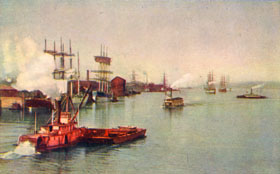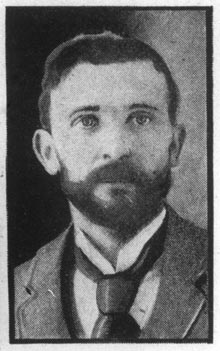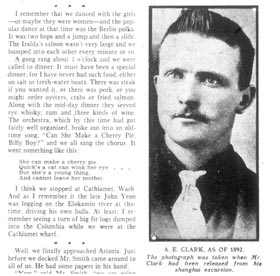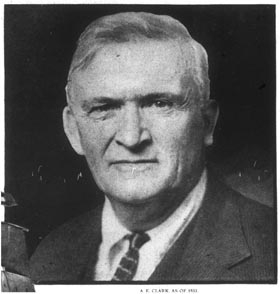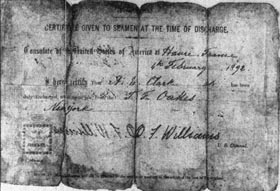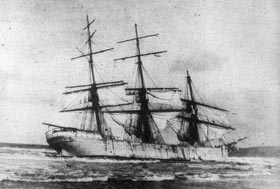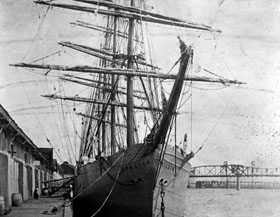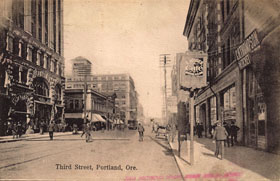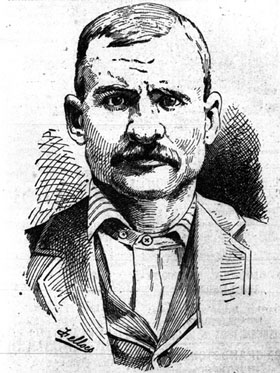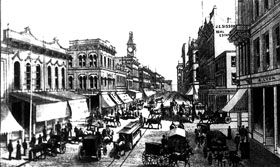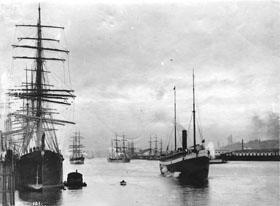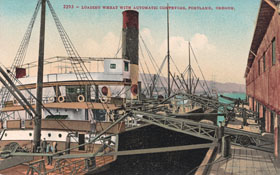
Chapter 5 | America's Most Pernicious Shanghai City:
PAGE 72:
A view of the Portland harbor in the 1890s. The picture is hand-tinted, and the strange pink color of the steamboat in the foreground is almost certainly an error made while coloring the image. (Image: Postcard)
BONUS IMAGE:
The riverboat Iralda under way. This is the boat on which the "going-away party"
for Aquilla Ernest Clark and his co-shanghaiees was held; a short version of Clark's story is at the beginning of Chapter 5. (Image: Portland Morning Oregonian, Oct. 29, 1933)
BONUS IMAGE:
This picture shows young Aquilla Ernest Clark as he appeared shortly before his shanghaiing at the hands of a man who was almost certainly Bunco Kelly. Clark's story is told at the beginning of Chapter 5. (Image: Portland Morning Oregonian, Oct. 29, 1933)
Click here to read the entire four-part series on Clark's career as an able-bodied mariner, published in October and November of 1933 and written by Stewart Holbrook. (It's a PDF file.)
Here's a photo of Clark a year or two later, shortly after his shanghaiing, in a photo made in a foreign port. (Image: Portland Morning Oregonian, Oct. 29, 1933)
This photo of Clark was made in 1933, many years after his shanghaiing, when he told his story to Oregonian writer Stewart Holbrook. (Image: (Image: Portland Morning Oregonian, Oct. 29, 1933)
BONUS IMAGE:
Clark's discharge papers issued after he left the employ of the T.F. Oakes in Le Havre, France, in early 1892. Clark treasured this document, although it had clearly had as rough a life as he. (Here's another link to the entire story, from Stewart Holbrook's four-part series in the Portland Morning Oregonian.) (Image: Portland Morning Oregonian, Oct. 29, 1933)
BONUS IMAGE:
The fate of the T.F. Oakes: The notorious "hell ship" went aground at Half Moon Bay in California in March 1898. By then it had been renamed "New York," perhaps in an attempt to lose the reputation for brutality and starvation that it had acquired under its earlier name. (Image: Portland Morning Oregonian, Nov. 26, 1933) [Click here to read a PDF of the Oregonian article on the Oakes' demise]
PAGE 73:
The four-masted, 2,300-ton barque Arracan, one of the last of the British grain fleet, at the wharf in 1913. (Image: Salem Public Library)
PAGE 76:
Third Street in Portland, looking northward. The tiny "X" at the vanishing point in this image was marked on this postcard by the person who mailed it in 1907, to denote his place of residence. (Image: Postcard)
PAGE 80:
Notorious shanghai artist Joseph "Bunco" Kelly, as drawn by the Portland Evening Telegram's staff artist during his trial for murder in 1894. (Image: Portland Evening Telegram)
PAGE 80:
A view looking north on First Street from its intersection with Morrison, looking north. The Snug Harbor Saloon and Johnson & Sons Undertaking Parlor were about one block to the left of this picture. (Image: The West Shore magazine)
PAGE 86:
A busy day in Portland's harbor. Judging by the ratio of sailing ships to steam vessels, this looks to have been made in the late 1890s or possibly the early 1900s. Either way, it's a sure thing the captain of every one of the ships you see in this picture knew who Larry Sullivan was. (Image: OSU Archives)
PAGE 89:
Longshoremen load sacks of wheat on a steamer at a Portland wharf using powered conveyer belts, around 1910. The switch from sails to steam eventually drove the shanghaiiers and crimps out of business. (Image: Postcard)
